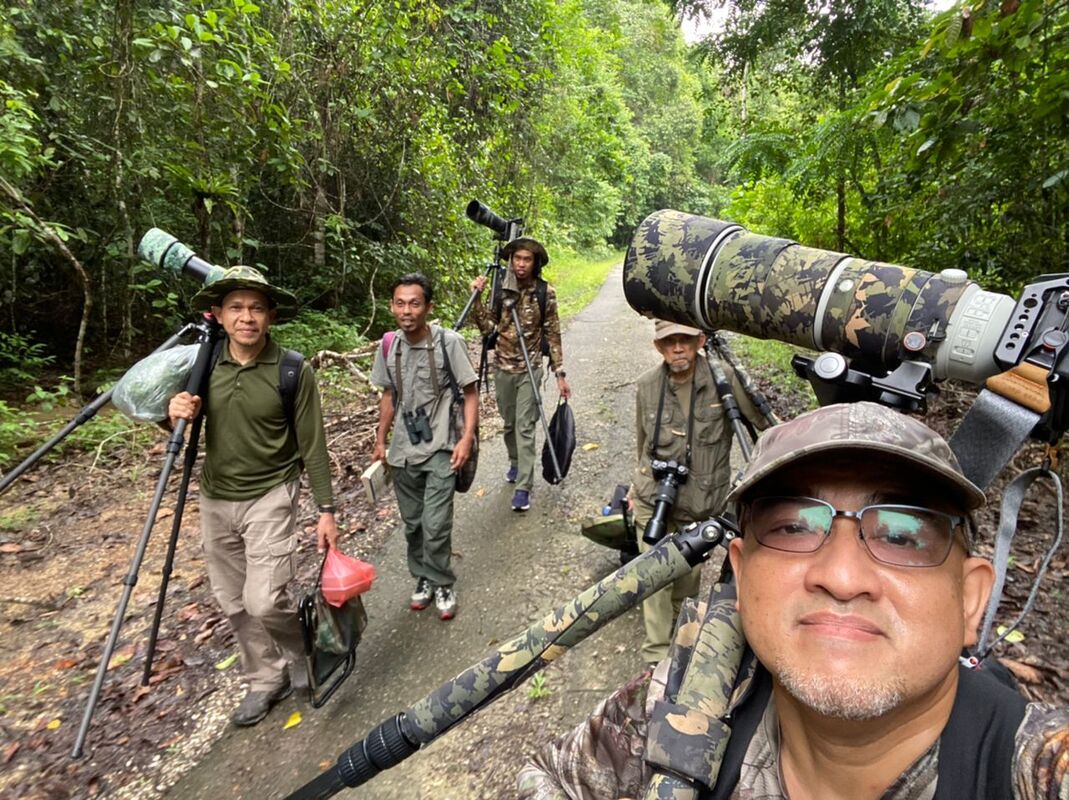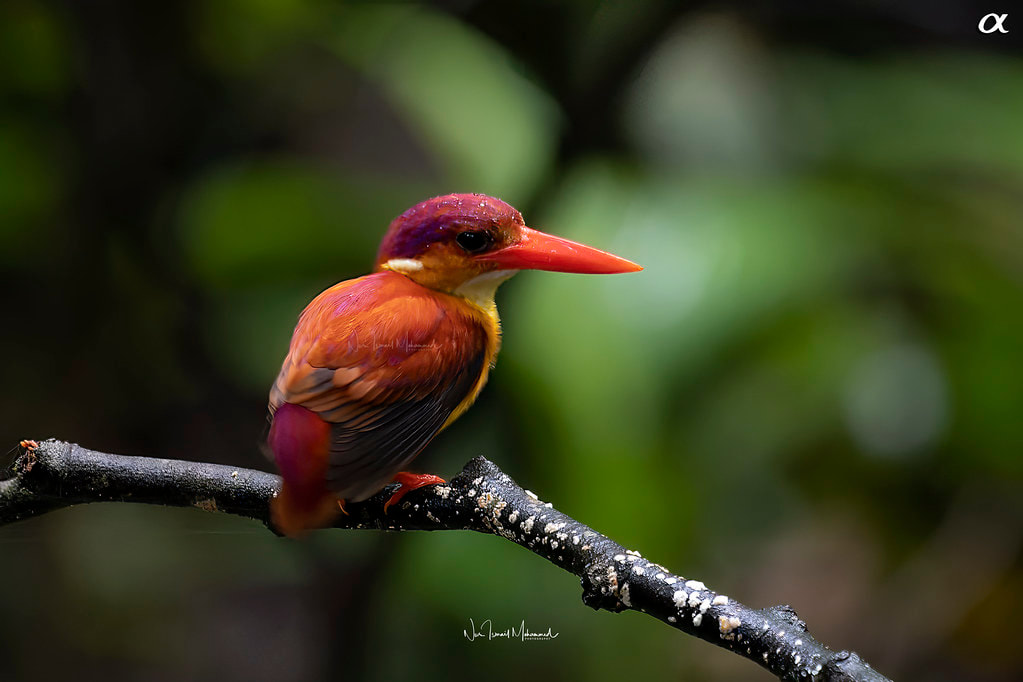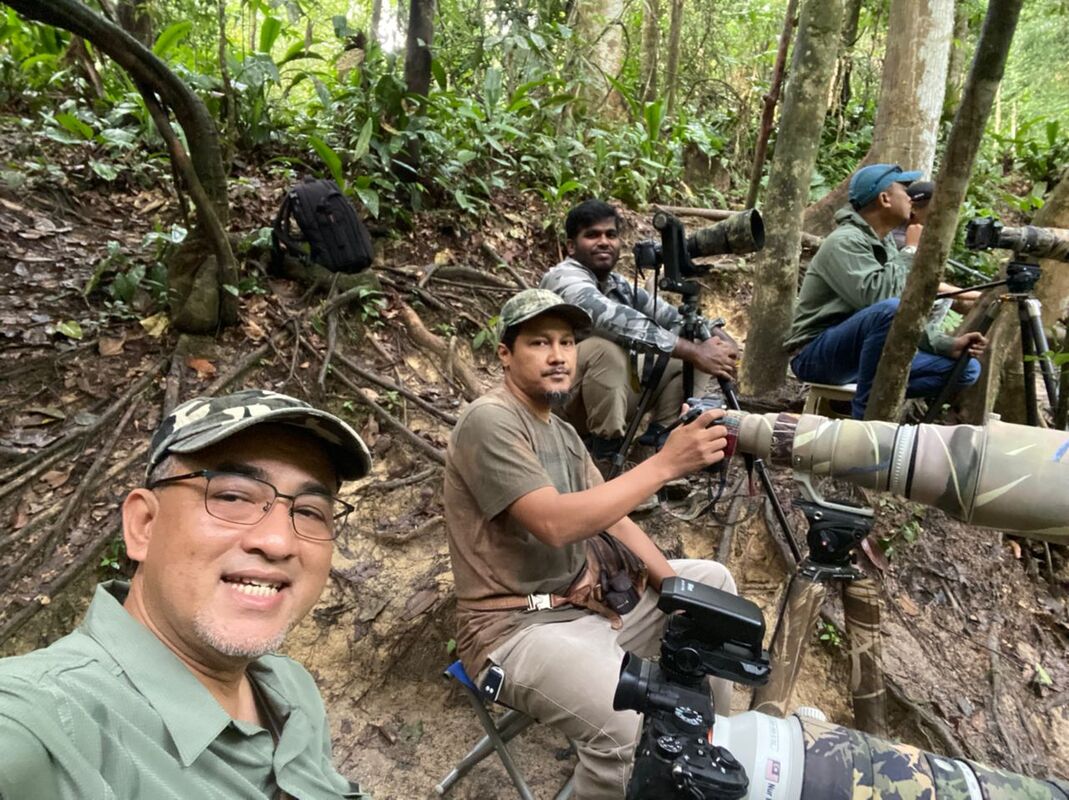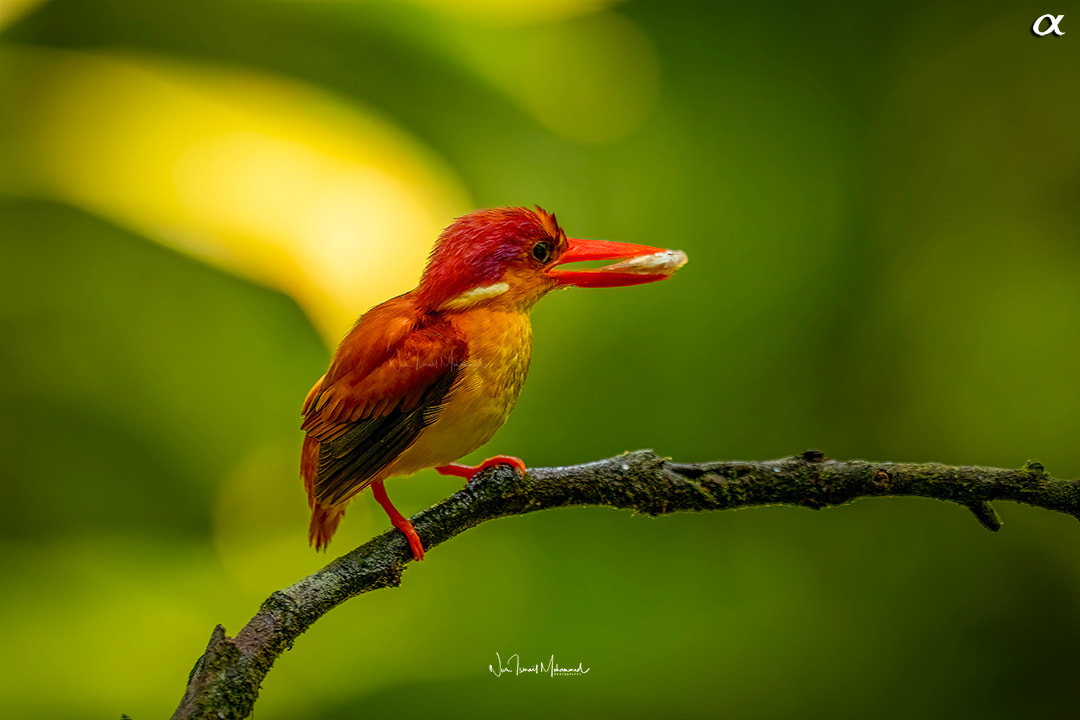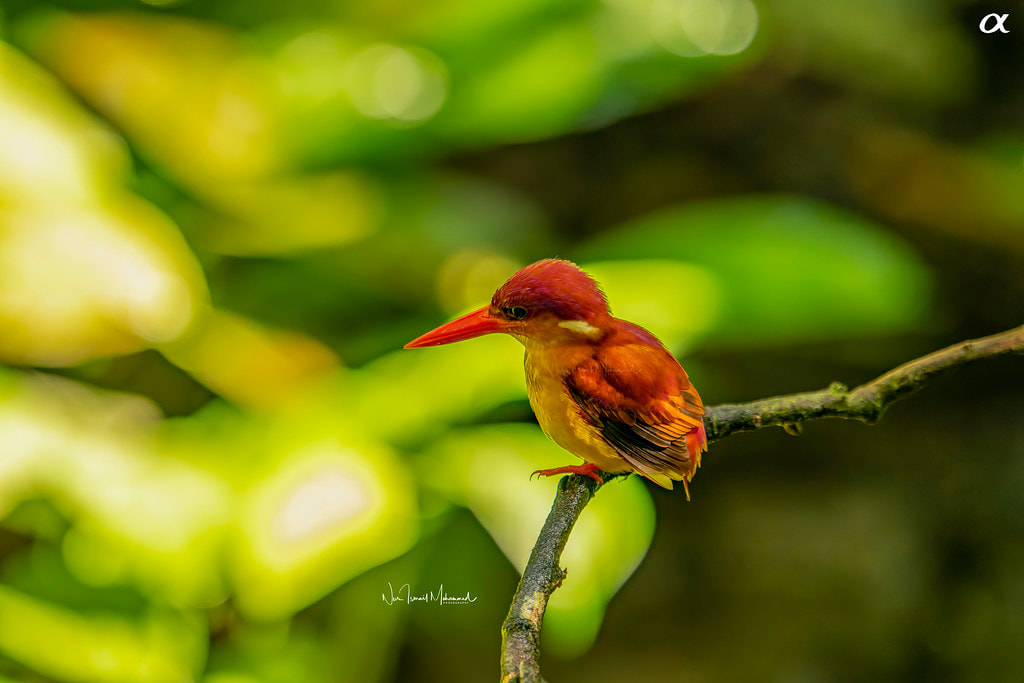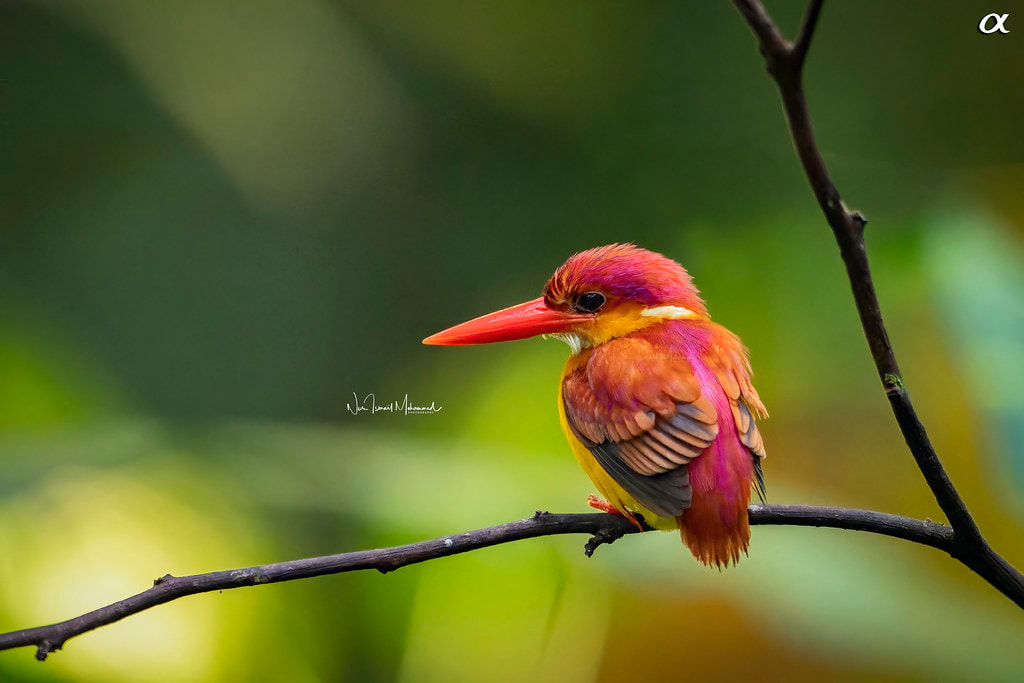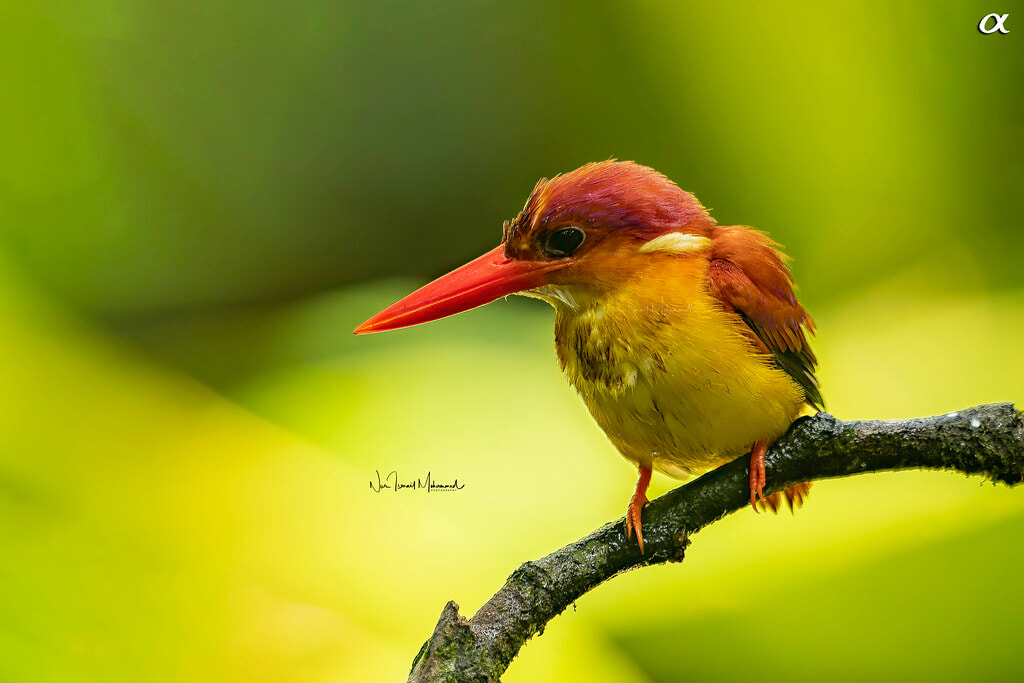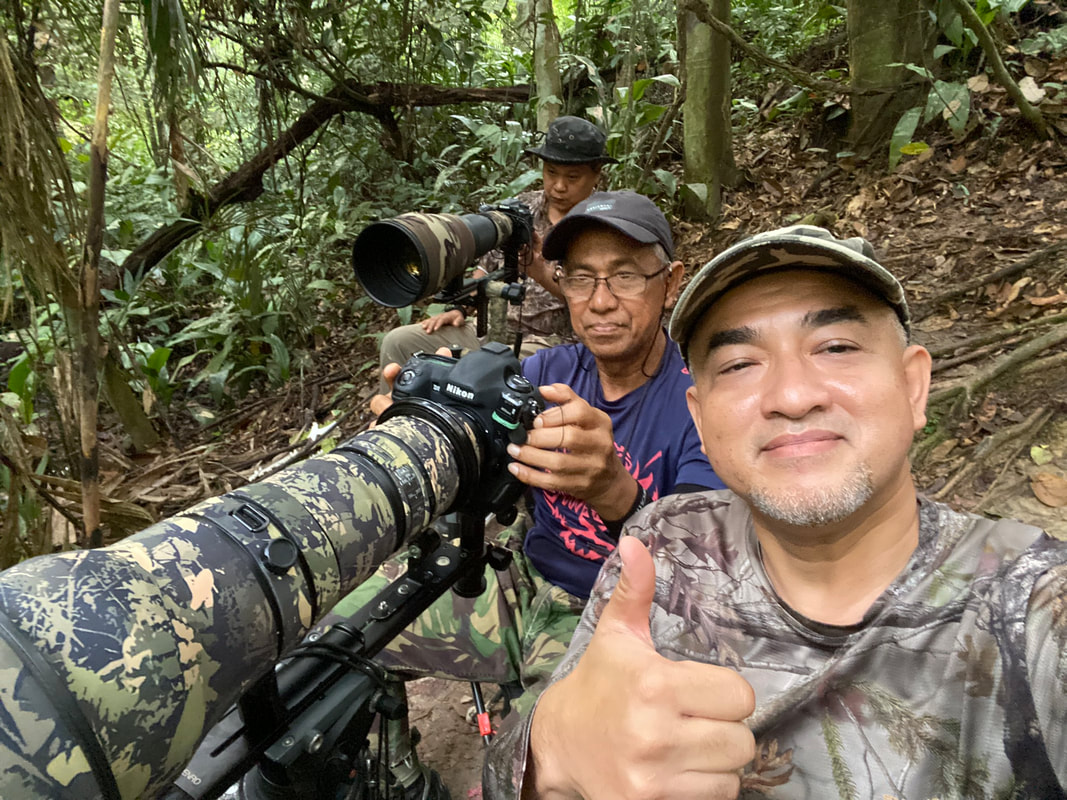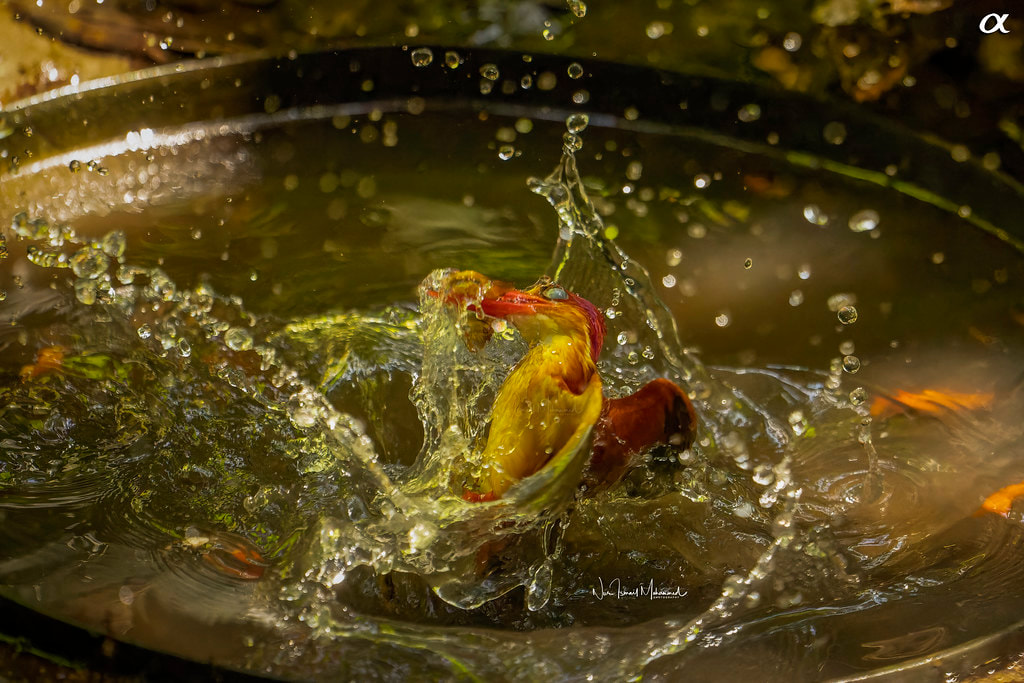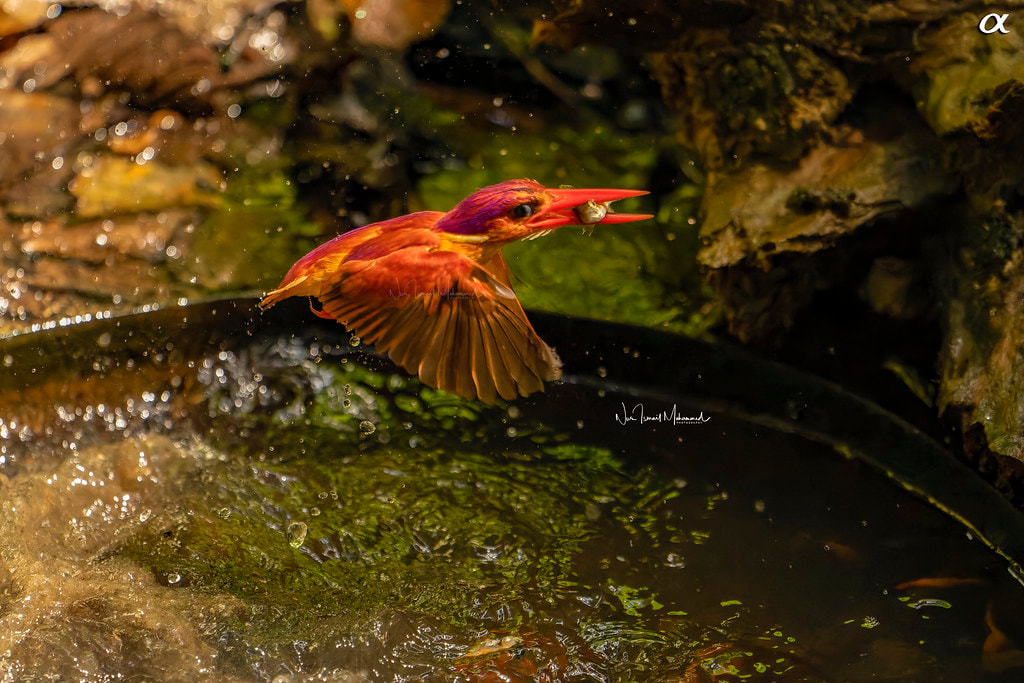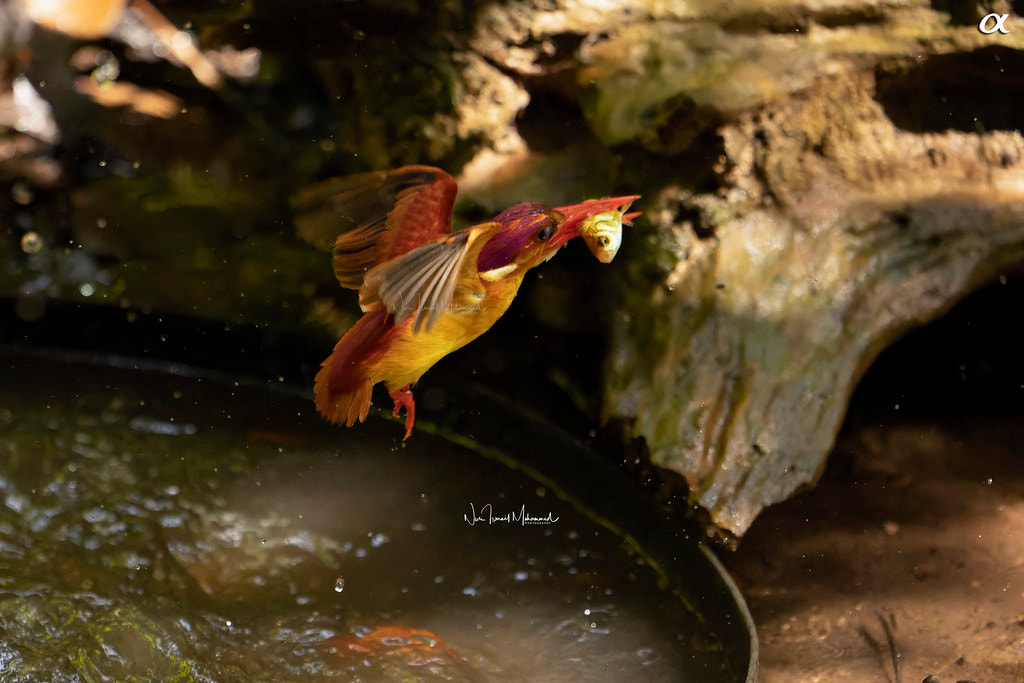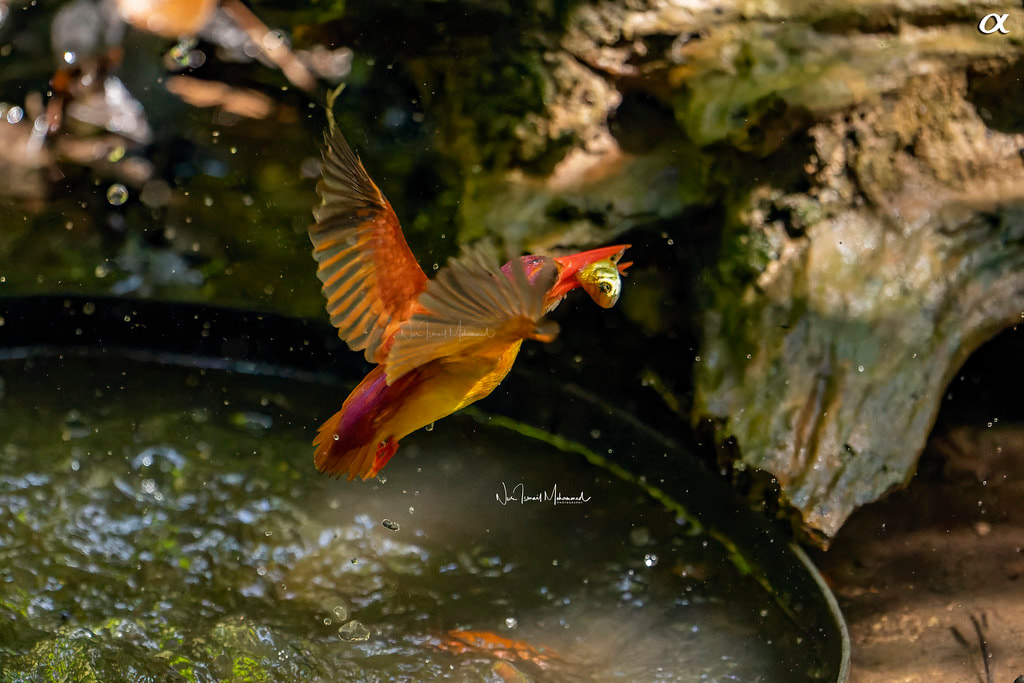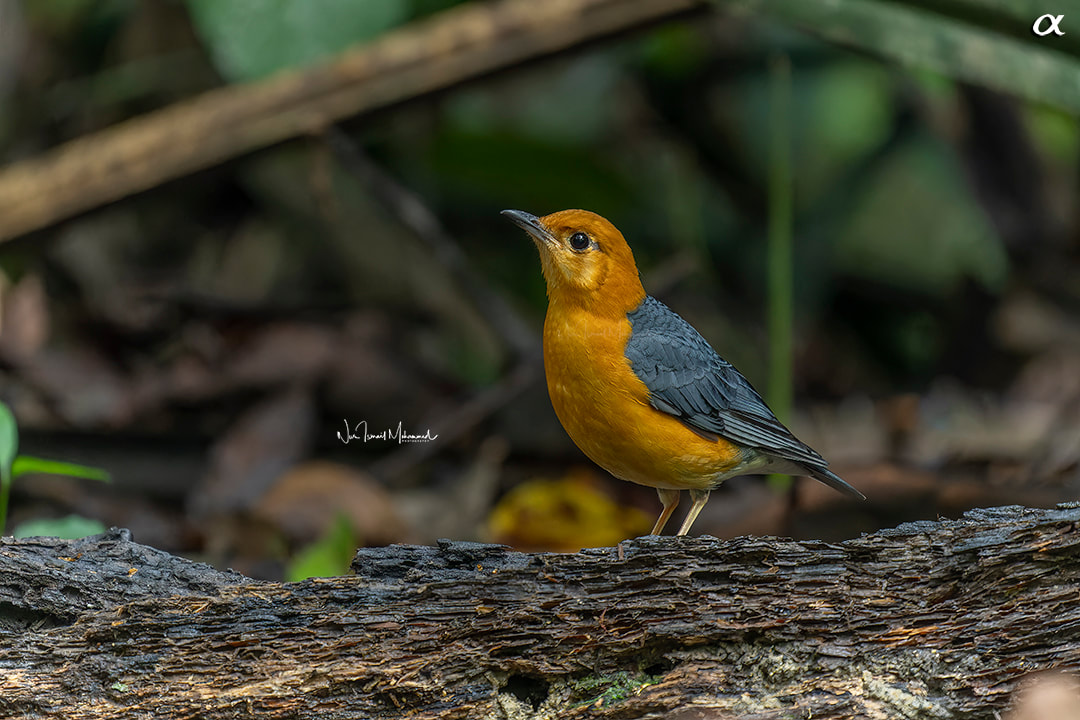|
During the DYMM SPB Agong's Birthday holiday, I went to Taman Negara Sungai Relau in Merapoh with some friends, namely Din Mohd Yaman, Apiq Sulaiman and Hj Arman Haron. We departed from KL at 4:15am on 5/6/2022 in one car. The journey takes 223km from Gombak Toll right to Taman Negara Sungai Relau and the journey takes about 3 hours 45 minutes, including stops for subuh prayer in Raub and Kuala Lipis for breakfast. We arrived at Taman Negara Sungai Relau by 8:45am. We started birding on 5/6/2022 with the main target, the garnet pitta, the jewel of Taman Negara Sungai Relau. We finished the first day around 5:00pm with no show of the garnet pitta. We continue birding again on 6/6/2022 where I've spend bulk of the time between 8:30am until 5:00pm in the hide. We were very unfortunate that the garnet pitta failed to show up on the feeding log, despite hearing its calls nearby. Looks like I have to plan another trip to Taman Negara Sungai Relau when it is open season for the garnet pitta, between early January till end May. List of birds (5/6/2002):
List of birds (6/6/2022):
#NurIsmailPhotography #sony #sonymalaysia #a1 #α1 #a7IV #α7IV #SEL100400GM #SEL200600G #alpha #AlphaGuru #SAG #DXO #PureRAW #topazlabs #leofoto #pg1 #Fight4ourPlanet #DiscoverWithMYAlpha #DiscoverWithAlpha #AlphaUniverseMY #FullFrameLife #MySONYLife Copyright © 2022 Nur Ismail Photography. All rights reserved. Do not use or reproduce these images on websites, blogs or publications without expressed written permission from the photographer. For any enquiries, please visit my website: www.nurismailphotography.com or email at [email protected]. Flickr: www.flickr.com/photos/nurismailphotography/
0 Comments
The Ceyx rufidorsa is a bird species in the Alcedinidae family. It is commonly known as the rufous-backed kingfisher. This species is found in Brunei, India, Indonesia, Malaysia, the Philippines, and Thailand in tropical lowland forests near lakeshores and streamsides. The rufous-backed kingfisher is a small bird usually in solitary and hunts from a low perch over the water by diving for insects including mantises (Mantodea), grasshoppers (Orthoptera), flies (Diptera), water beetles (Dytiscidae), winged ants (Formicidae) and frogs. It is sometimes considered as a subspecies of the Oriental dwarf kingfisher (Ceyx erithaca). [Source: MyBIS] During my recent visit to Hulu Langat, I've also managed to capture some of the kingfishers detailed portrait shots using SONY's flagship α1 camera and the new SONY α7IV with the SEL200600G and SEL100400GM lenses. The challenge was to shoot the kingfisher in low light due to forest canopy, but the problem is easily solve due to the high ISO capability of the SONY cameras and post processed using Topaz Labs plugins. Name: Rufous-backed kingfisher Scientific: Ceyx rufidorsa Malay: Pekaka Api Family: Alcedinidae IUCN Red List (v3.1, 2016): Least Concern Location: Hulu Langat, Selangor #NurIsmailPhotography #sony #sonymalaysia #a1 #α1 #a7IV #α7IV #SEL100400GM #SEL200600G #alpha #AlphaGuru #SAG #DXO #PureRAW #topazlabs #leofoto #pg1 #Fight4ourPlanet #DiscoverWithMYAlpha #DiscoverWithAlpha #AlphaUniverseMY #FullFrameLife #MySONYLife Copyright © 2022 Nur Ismail Photography. All rights reserved. Do not use or reproduce these images on websites, blogs or publications without expressed written permission from the photographer. For any enquiries, please visit my website: www.nurismailphotography.com or email at [email protected]. Flickr: www.flickr.com/photos/nurismailphotography/ A very characteristic bird of the wetlands, known as Collared Kingfisher belongs to family Alcedinidae. It can be found mostly at tidal mangroves, sandy beaches and coastal scrub, sometimes also at inland gardens and parks. Its size can reach up to 24 cm in length. In appearance, the Collared Kingfisher has a turquoise head and upperparts contrast with the white colour on its collar and underparts. It feeds on crabs, worms, large insects and lizards (Strange & Jeyarajasingam, 1993). [Source: MyBIS] Name: Collared kingfisher Scientific: Todiramphus chloris Malay: Pekaka Bakau / Pekaka Sungai Family: Alcedinidae IUCN Red List (v3.1, 2016): Least Concern Gear: SONY α1 + SEL200600G + SEL14TC Location: Pantai Balok, Kuantan, Pahang #NurIsmailPhotography #sony #sonymalaysia #a1 #α1 #SEL200600G #SEL14TC #alpha #AlphaGuru #SAG #DXO #PureRAW #topazlabs #leofoto #pg1 #Fight4ourPlanet #DiscoverWithMYAlpha #DiscoverWithAlpha #AlphaUniverseMY #FullFrameLife #MySONYLife
Copyright © 2022 Nur Ismail Photography. All rights reserved. Do not use or reproduce these images on websites, blogs or publications without expressed written permission from the photographer. For any enquiries, please visit my website: www.nurismailphotography.com or email at [email protected]. Flickr: www.flickr.com/photos/nurismailphotography/ A very characteristic bird of the wetlands, known as Collared Kingfisher belongs to family Alcedinidae. It can be found mostly at tidal mangroves, sandy beaches and coastal scrub, sometimes also at inland gardens and parks. Its size can reach up to 24 cm in length. In appearance, the Collared Kingfisher has a turquoise head and upperparts contrast with the white colour on its collar and underparts. It feeds on crabs, worms, large insects and lizards (Strange & Jeyarajasingam, 1993). [Source: MyBIS] Name: Collared kingfisher Scientific: Todiramphus chloris Malay: Pekaka Bakau / Pekaka Sungai Family: Alcedinidae IUCN Red List (v3.1, 2016): Least Concern Gear: SONY α1 + SEL200600G + SEL14TC Location: Pantai Balok, Kuantan, Pahang #NurIsmailPhotography #sony #sonymalaysia #a1 #α1 #SEL200600G #SEL14TC #alpha #AlphaGuru #SAG #DXO #PureRAW #topazlabs #leofoto #pg1 #Fight4ourPlanet #DiscoverWithMYAlpha #DiscoverWithAlpha #AlphaUniverseMY #FullFrameLife #MySONYLife
Copyright © 2022 Nur Ismail Photography. All rights reserved. Do not use or reproduce these images on websites, blogs or publications without expressed written permission from the photographer. For any enquiries, please visit my website: www.nurismailphotography.com or email at [email protected]. Flickr: www.flickr.com/photos/nurismailphotography/ The Ceyx rufidorsa is a bird species in the Alcedinidae family. It is commonly known as the rufous-backed kingfisher. This species is found in Brunei, India, Indonesia, Malaysia, the Philippines, and Thailand in tropical lowland forests near lakeshores and streamsides. The rufous-backed kingfisher is a small bird usually in solitary and hunts from a low perch over the water by diving for insects including mantises (Mantodea), grasshoppers (Orthoptera), flies (Diptera), water beetles (Dytiscidae), winged ants (Formicidae) and frogs. It is sometimes considered as a subspecies of the Oriental dwarf kingfisher (Ceyx erithaca). [Source: MyBIS] During my recent visit to the old rufous-backed kingfisher spot in Hulu Langat, I've also managed to capture some of the kingfishers detailed portrait shots using SONY's flagship α1 camera and the 600mm F/4 GM lens, thanks to the 50MP capability of SONY α1 camera. The challenge was to shoot the kingfisher in low light due to forest canopy, but the problem is easily solve due to the high ISO capability of the SONY α1 camera and post processed using Topaz Labs plugins. Name: Rufous-backed kingfisher Scientific: Ceyx rufidorsa Malay: Pekaka Api Family: Alcedinidae IUCN Red List (v3.1, 2016): Least Concern Location: Hulu Langat, Selangor #NurIsmailPhotography #sony #sonymalaysia #a1 #α1 #SEL600F40GM #SEL200600G #alpha #AlphaGuru #SAG #DXO #PureRAW #topazlabs #leofoto #pg1 #Fight4ourPlanet #DiscoverWithMYAlpha #DiscoverWithAlpha #AlphaUniverseMY #FullFrameLife #MySONYLife
Copyright © 2022 Nur Ismail Photography. All rights reserved. Do not use or reproduce these images on websites, blogs or publications without expressed written permission from the photographer. For any enquiries, please visit my website: www.nurismailphotography.com or email at [email protected]. Flickr: www.flickr.com/photos/nurismailphotography/ The Ceyx rufidorsa is a bird species in the Alcedinidae family. It is commonly known as the rufous-backed kingfisher. This species is found in Brunei, India, Indonesia, Malaysia, the Philippines, and Thailand in tropical lowland forests near lakeshores and streamsides. The rufous-backed kingfisher is a small bird usually in solitary and hunts from a low perch over the water by diving for insects including mantises (Mantodea), grasshoppers (Orthoptera), flies (Diptera), water beetles (Dytiscidae), winged ants (Formicidae) and frogs. It is sometimes considered as a subspecies of the Oriental dwarf kingfisher (Ceyx erithaca). [Source: MyBIS] During my recent visit to the old rufous-backed kingfisher spot in Hulu Langat, I've also managed to capture some of the kingfishers detailed portrait shots using SONY's flagship α1 camera and the 600mm F/4 GM lens, thanks to the 50MP capability of SONY α1 camera. The challenge was to shoot the kingfisher in low light due to forest canopy, but the problem is easily solve due to the high ISO capability of the SONY α1 camera and post processed using Topaz Labs plugins. Name: Rufous-backed kingfisher Scientific: Ceyx rufidorsa Malay: Pekaka Api Family: Alcedinidae IUCN Red List (v3.1, 2016): Least Concern Location: Hulu Langat, Selangor #NurIsmailPhotography #sony #sonymalaysia #a1 #α1 #SEL600F40GM #SEL200600G #alpha #AlphaGuru #SAG #DXO #PureRAW #topazlabs #leofoto #pg1 #Fight4ourPlanet #DiscoverWithMYAlpha #DiscoverWithAlpha #AlphaUniverseMY #FullFrameLife #MySONYLife Copyright © 2022 Nur Ismail Photography. All rights reserved. Do not use or reproduce these images on websites, blogs or publications without expressed written permission from the photographer. For any enquiries, please visit my website: www.nurismailphotography.com or email at [email protected]. Flickr: www.flickr.com/photos/nurismailphotography/ The Ceyx rufidorsa is a bird species in the Alcedinidae family. It is commonly known as the rufous-backed kingfisher. This species is found in Brunei, India, Indonesia, Malaysia, the Philippines, and Thailand in tropical lowland forests near lakeshores and streamside. The rufous-backed kingfisher is a small bird usually in solitary and hunts from a low perch over the water by diving for insects including mantises (Mantodea), grasshoppers (Orthoptera), flies (Diptera), water beetles (Dytiscidae), winged ants (Formicidae) and frogs. It is sometimes considered as a subspecies of the Oriental dwarf kingfisher (Ceyx erithaca). [Source: MyBIS] Last weekend I took the opportunity to visit the old spot in Hulu Langat for this kingfisher, after getting info from my friends that the rufous-backed kingfisher is feeding again. My last visit to photograph the rufous-backed kingfisher was early February 2020. After the first MCO and 2nd MCO, I went back to the spot, but the rufous-backed kingfisher was never found. This time around, equipped with SONY's flagship α1 camera and the 600mm F/4 GM lens, I was able to capture some of the bird in flight shots of the kingfisher, thanks to the 30fps capability of SONY α1 camera, I managed to capture series of the in flight shots. The only challenge is focusing on the right subject to anticipate the position where the kingfisher will dive for the fish. Name: Rufous-backed kingfisher Scientific: Ceyx rufidorsa Malay: Pekaka Api Family: Alcedinidae IUCN Red List (v3.1, 2016): Least Concern Location: Hulu Langat, Selangor #NurIsmailPhotography #sony #sonymalaysia #a1 #α1 #SEL600F40GM #SEL200600G #alpha #AlphaGuru #SAG #DXO #PureRAW #topazlabs #leofoto #pg1 #Fight4ourPlanet #DiscoverWithMYAlpha #DiscoverWithAlpha #AlphaUniverseMY #FullFrameLife #MySONYLife
Copyright © 2022 Nur Ismail Photography. All rights reserved. Do not use or reproduce these images on websites, blogs or publications without expressed written permission from the photographer. For any enquiries, please visit my website: www.nurismailphotography.com or email at [email protected]. Flickr: www.flickr.com/photos/nurismailphotography/ Actenoides concretus is commonly known as the rufous-collared kingfisher. The adult has medium size with a proportioned head. The rufous-collared kingfisher has a shaggy crest, large and thick bill, blue head and back, and white throat and collar. It's underbody is white and has blue band across its chest. Both male and female has a slight differences appearance, where the male does not have the rufous band across its white abdomen, but present in its flanks. An addition for the female, some feather tips along the blue breast are rufous. Their diet includes fishes, insects, scorpions and small snakes. The rufous-collared kingfisher is confined to the Sundaic lowlands, which include Malaysia, Myanmar, Indonesia, Thailand and Brunei Darussalam (Jeyarajasingam & Pearson, 2012). It was regionally extinct in Singapore. Its habitat constitutes the closed canopy forest and regenerating logged forest. Due to forest loss, forest fires and land conversion, this species is listed as Near Threatened in the IUCN Red List (BirdLife International, 2016). [Source: MyBIS]. Name: Rufous-collared kingfisher Scientific: Actenoides concretus Malay: Pekaka Rimba Besar / Pekaka Tengkuk Perang Family: Alcedinidae IUCN Red List (v3.1, 2016): Near Threatened Gear: SONY α1 + SEL200600G Location: Bukit Larut, Taiping, Perak. #NurIsmailPhotography #sony #sonymalaysia #a1 #α1 #SEL200600G #alpha #AlphaGuru #SAG #DXO #PureRAW #topazlabs #leofoto #pg1 #Fight4ourPlanet #DiscoverWithMYAlpha #DiscoverWithAlpha #AlphaUniverseMY #FullFrameLife #MySONYLife
Copyright © 2022 Nur Ismail Photography. All rights reserved. Do not use or reproduce these images on websites, blogs or publications without expressed written permission from the photographer. For any enquiries, please visit my website: www.nurismailphotography.com or email at [email protected]. Flickr: www.flickr.com/photos/nurismailphotography/ Geokichla citrina is known as Orange-headed Thrush, or locally called Murai Belanda or Murai Dada Oren. This is due to the orange colour appearing from its head to its breast. Geokichla citrina belongs to the family Turdidae and can grow up to 23 cm and weight until 67 g. Geokichla citrina can be found near understory of moist deciduous forest and evergreen forest, mixed secondary and bamboo thickets. The coverage range of this species is from the Himalayas, South China through to Southeast Asia including Malaysia. The diet of this species includes insect, invertebrates like worms and snails, as well as the fruits of Macaranga sp. Until now, this species is listed as Least Concern in the IUCN status, yet, the population is subject to a declining trend owing to the cage-bird trade and continuing forest loss (IUCN, 2016). [Source: MyBIS]. Name: Orange-headed thrush Scientific: Geokichla citrina Malay: Murai Belanda / Murai Dada Oren Family: Turdidae IUCN Red List (v3.1, 2019): Least Concern Gear: SONY α1 + SEL200600G Location: Bukit Larut, Taiping, Perak #NurIsmailPhotography #sony #sonymalaysia #a1 #α1 #SEL200600G #alpha #AlphaGuru #SAG #DXO #PureRAW2 #topazlabs #leofoto #pg1 #Fight4ourPlanet #DiscoverWithMYAlpha #DiscoverWithAlpha #AlphaUniverseMY #FullFrameLife #MySONYLife Copyright © 2022 Nur Ismail Photography. All rights reserved. Do not use or reproduce these images on websites, blogs or publications without expressed written permission from the photographer. For any enquiries, please visit my website: www.nurismailphotography.com or email at [email protected]. Flickr: www.flickr.com/photos/nurismailphotography/ |
AuthorThis is the photography journey of Nur Ismail Photography where all the experiences from this year onwards will be shared with the audience. In collaboration with NiSi Malaysia, Leofoto, SONY Malaysia and Skylum Software. Thanks for viewing! Archives
August 2022
Categories |
